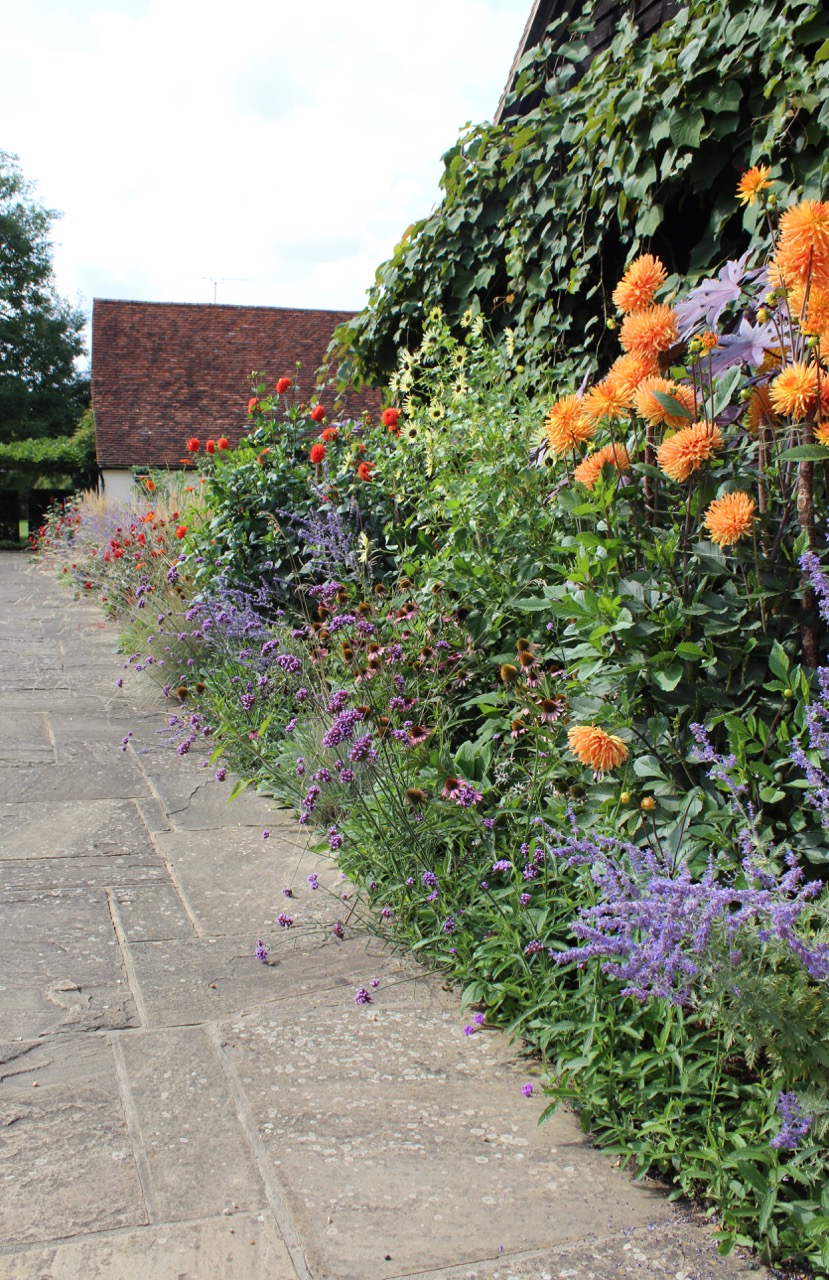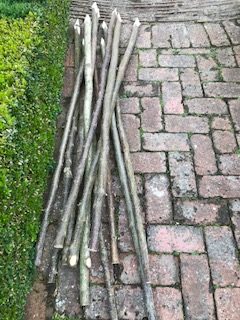I’ve often written that in some ways growing dahlias well is the easiest thing in the world and by equal measure, tricky. If you can get past the slugs, supporting dahlias is the most challenging bit to get right. To help explain dahlia supports, I turned to Philippa Burrough of Ulting Wick, a garden open for the NGS charity, and Richard Ramsey, owner of Withypitts, a dahlia farm (yes such a place exists!) for cut dahlias. Two people and their teams I respect greatly for the expert dahlia skills.

Dahlias grown to perfection at Ulting Wick 
When fully grown the supports are hidden
Why support dahlias?
“It is important to support dahlia plants well because the secondary stem joints are very brittle where they join the main stem and prone to fracturing either in windy conditions or just the sheer weight of the stem.” says Richard. Something I’ve experienced first hand on our little patio, which can act as a wind trap for strong gusts, snapping dahlia stems.
Smaller dwarf dahlias may not need any support or only a little. Philippa told me that “for shorter dahlias such as the Bishop series I will use pea sticks to give gentle support.” In addition to the Bishop series dahlias, there is also the Art series and various other patio dahlias.

But let’s face it, if you’re reading this you’re in the dahlia game for the big showstoppers. The ‘Cafe au Lait’, ‘Labyrinth’ beauties that light up Instagram each year. Any dahlia that grows above 70cm, which is most of them, will need support.
Staking in flower borders
Trickiest is supporting dahlias in borders where you want to see the flowers but not a load of sticks and string. Philippa says that at Ulting Wick “we use robust 5ft hazel stakes for the tall dahlias such as ‘Ambition’ that we use in the tropical beds. They look somewhat incongruous at this time of the year but by the end of the season they will have disappeared under the foliage.”

“Generally I put 3 or 4 stakes around each dahlia and then do a cats cradle of twine around all the stakes for support. As I always plant dahlias in groups for impact, some dahlias “share” the stakes with their neighbour.” Luck would have it that I contacted Philippa at the very moment she was staking her dahlias and she incredibly helpfully sent a series of photos to demonstrate:
“As the season goes on I am stringing the dahlias perhaps every 10 days as they grow. By stringing it allows you to tame them a little if they grow towards light as the other plants around them begin to shade them.”
Supporting dahlias in pots
From my own experiments at home, growing around forty different cultivars of dahlia at all different sizes, I know you can grow any dahlia well in a pot at least 35-40cm wide. The problem with the bigger ones is that they become top heavy, not recommended but possible. In terms of supporting them the advice remains the same as Philippa’s above.
I have a variety of metal supports offering the same strength but are less visible. Some, bought years ago, are coated in plastic; if I could turn back the clock I would buy plain metal for the aesthetic and to be environmentally friendly but reusing them is now the best option. For shorter dahlias to 1m max, ring supports with grids are adequate. Pompon dahlias tend to only grow this tall.

For larger normal sized dahlias I have longer rods which I twine in the same way that Philippa suggests although the size of the pot restricts how far from the plant they can be placed. Although unsightly they will soon be covered by foliage.

Supporting dahlias for cut flowers
On my allotment I grow dahlias for cut flowers but this year I wanted to do this properly and spoke to Richard for advice. “Ideally dahlias should be supported by a post rather than a bamboo cane which may bend with the weight of the foliage or wind strength.” I’ve replaced all of my canes with posts this year as a result.
“The post should be placed about 30 cm from the plant, the length height should be around 3/4 the height of the plant. This ensures good support yet no unsightly posts to detract from the beauty of the dahlia. The post should be placed at time of planting or very soon after so as not to damage the root structure. The first tie should be made as soon as possible to support the early growth and keep the main stems erect. Add further ties as the plants gain height.”

“If dahlias are being grown in a cutting garden then plant in beds of two rows 60 cm x 60 cm. Place posts at each corner and along the length to support “pea and bean” netting. We use 100 cm, wide with 15 cm mesh. Stretch this horizontally across the posts beginning at around 25 – 30 cm and gradually raise the height as the plants grow. As this is a cutting garden the blooms will be harvested frequently (or deadheaded) keeping the plant less bushy than they would be as a border feature.”
I’m obsessed with dahlias, where can I learn more?
If you’re looking for general dahlia growing advice please look through my previous dahlia blogs and I recommend reading all three of the following books: Dahlias: beautiful varieties for home and garden by Naomi Slade, Plant Lover’s Guide to Dahlias by Andy Vernon and the one most people won’t have heard of, Dahlias for You by Ted Collins for the National Dahlia Society. They all have crossover but I learnt something new from each one, the latter is small but cuts to the point with practical info.
With a huge thanks to Philippa Burrough and Richard Ramsey for taking the time to contribute to this article, please do visit their websites:
www.ultingwickgarden.co.uk
www.withypitts-dahlias.co.uk








That is way cool. Thank you for the ideas. My giant zinnias can benefit from this as well. As always, thank you for taking time you don’t have to share photos and what you’ve learned and where you guys have been.
Found that interesting. I was given Dahlia My Love last autumn. It was so large and I wanted to split it but there were no obvious places to put in my spade so I planted it whole. It has been magnificent but unsupported and therefore not seen at its best and the adjacent plants haven’t been best pleased !
I don’t lift my dahlias as I am on sand and they always survive winters so I will have to risk damaging any roots when putting in stakes and will certainly do as you suggest with twine.